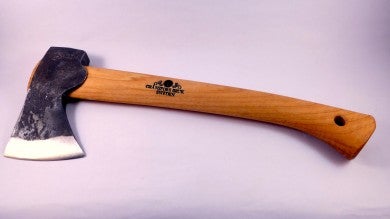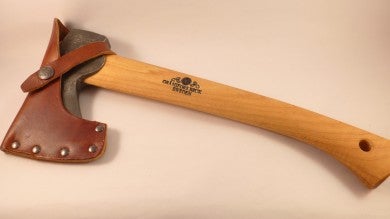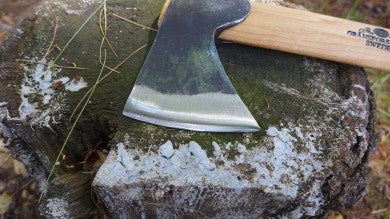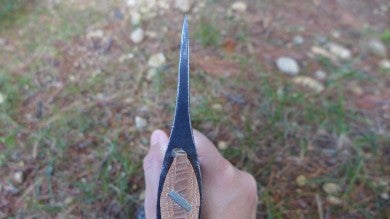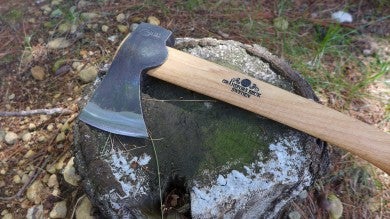Review: Gransfor Bruks Wildlife Hatchet
Tony Sculimbrene 12.26.14

A Gransfors Bruks tool is something of a milestone in your road to total gear addiction. You’ve passed the point where everything needs to be pristine satin finishes and gleaming carbon fiber. You’ve long since blown by the infatuation with FRN and its weight saving benefits. At long last you have come full circle–back to the hatchet or axe aisle at your local hardware store. Except now, you know what makes run-of-the-mill hardware store tools garbage, and you can appreciate the resplendent beauty of a Gransfors Bruks tool.
The perfectly straight grain of the handle and the immaculate convex edge aren’t things you can truly be grateful for until you have used a bunch of gear. Once you have (and boy have I used my fair share of gear over the past four or so years), you get this thing in your hand and it just sings. It tickles all of your gear loving brain structures, but it also makes you happy that there are still traditional tools crafted in the old way out there. You’ll also love the simple, yet sumptuous materials. This is a tool to use, to appreciate, and frankly, to get attached to. Gransfors Bruks stuff is so highly regarded because it is so damn good. The Wildlife Hatchet is no exception.
Description
Here is the product page. This is a small hatchet.
The hatchet weighs in at under two pounds, and the steel is a high carbon steel of unspecified designation. The handles are made of straight grain American Hickory. The axe head itself is partially finished, with a forged surface at the rear and a high polish near the front and covering the cutting edge.
The axe head is convex ground, and its eye is oval with a metal wedge (which could be called a floating tennon or a spline, but axe terminology calls it a wedge) in the center. The handle is finished with a surface treatment, probably either a BLO/wax mix (boiled linseed oil) or a tung oil. The handle is also wonderfully curved and contoured, with a pronounced hook and flair at the end of the handle. The leather sheath is simple, smooth to the touch, and classically colored a deep coffee brown. The snap on the sheath is a brass snap.
Testing
I purchased the GB Small Wildlife Hatchet (GB WH) at the beginning of August and took it on two camping trips. It also helped me process wood for the winter. Finally, I took it on more than a few day hikes and used it extensively in delimbing and processing small trees. I cut a wide range of wood with it, both green and dried. I also used it to cut a number of difference species, including oak, maple, hickory, poplar, and a few woods I couldn’t identify. During hikes I would either lash the hatchet to my pack or carry it on my belt, using the supplied sheath (the snapping strap and the head are tucked in to your belt and when the snap is closed, the axe is really locked in).
The GB WH made very short work of most green woods, even hardwoods. Only hickory proved to be a daunting challenge, and given how it rebuked everything else I had, I think it was not a problem with the hatchet, but the strength of the tree itself. A few Bark Rivers and Ka-Bars bounced off with even less success than the GB WH.
Design
The design of a hatchet has remained essentially unchanged for something like 25,000 years–stick with heavy, pointy mass at one end, held in place by various means. It’s pretty darn simple and pretty darn effective. The GB WH doesn’t mess with that formula at all. Instead it simplifies and perfects it until the final product is a seductively beautiful and effective tool.
The GB WH is both a hipster’s tool (it looks good, rugged, and authentic) and a real tool (it works exceedingly well). The choice of a convex grind is the right one, and the gracile form of the handle is simply splendid in use. The reprieve from modern materials is a welcome one. GB could have used some high impact FRN or thermoplastic handle, one that would be ostensibly indestructible, but they decided not to do that, and the hatchet is better for it. The hatchet may not be “put in a chipper/shredder” indestructible, but it is pretty darn close and still feels like the wonderfully handmade object that it is.
One thing to note: the things that make the GB WH great are small details, and they are things that are hard to appreciate out of context. If this was your first hatchet, you’d probably never realize how good it was until you used something else. And if this is not your first hatchet, then you are in the right frame of mind to appreciate its greatness.
Implementation
The gleaming axe head is a marvel. It looks like a gem and works amazingly well.
The convex ground edge is really a marvel, thick enough to pop wood apart, but still slender enough to really bite in.
The handle is also noteworthy. In the end, it was the shape and feel of the handle that was the final note in the siren’s song. The Wetterling I handled around the same time was probably just as nice, but its handle felt, well, off. Here, on the GB WH, the handle felt as if it were made for my hand, match on par with Thor and Mjolinor. The GB WH doesn’t have a homing feature like Mjolinor, but everything else made it feel as if it were made just for me. It’s that damn good. I would have liked a small lanyard, a strip of leather for example, but alas I will have wait until Thor lends me his tool to get one.
Conclusion
This is an aficiando’s tool.
